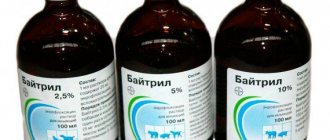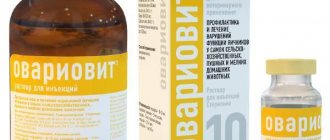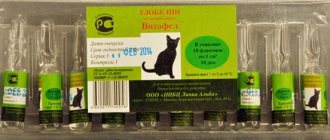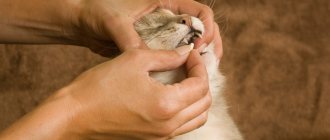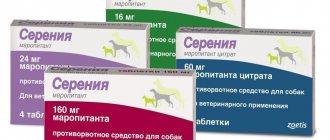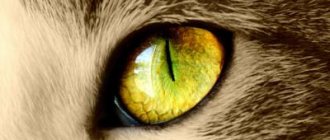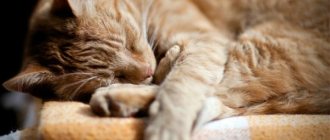Vitamin B12 is the most prescribed drug from the group of vitamins B by veterinarians. “Cyanocobalamin” for cats is indicated for hematopoiesis disorders, skin lesions and diseases of the nervous system. With proper nutrition, the substance enters the body with products of animal origin: fish, dairy products, eggs. However, for a number of diseases, operations, poisoning with heavy metal salts, the drug is additionally prescribed in the form of injections.
Composition and properties of "Cyanocobalamin"
The red injection solution is a complex of biologically active elements containing cobalt. According to its properties, the substance is a water-soluble vitamin, which practically eliminates overdose during treatment (the required amount is excreted in the urine). It accumulates in the kidneys, lungs, spleen, and most of all in the liver. Performs important functions in the body:
- affects the formation and maturation of blood cells;
- activates the blood coagulation system;
- needed for growth and normal development;
- has a beneficial effect on the functioning of the liver and central nervous system.
TSAMAX INTERNATIONAL
- 12832
DESCRIPTION
Vitamin B12 is the only water-soluble vitamin that can accumulate in the body; it is deposited in the liver, kidneys, lungs and spleen.
Cyanocobalamin is an odorless, dark red crystalline powder. Cyanocobalamin is relatively stable in light and at high temperatures.
In the body of animals and humans, cyanocobalamin is synthesized by intestinal microorganisms, from where it enters various organs; it accumulates especially in the kidneys, liver, and intestinal walls.
Together with the proteins of the gastric juice, vitamin B12 is easily absorbed in the intestines and ends up in the liver. From here, it enters the bone marrow as needed, regulating hematopoiesis and promoting normal maturation of red blood cells.
Together with folic acid, vitamin B12 is involved in the synthesis of hemoglobin. Blood clotting directly depends on it. In addition, cyanocobalamin significantly affects carbohydrate, fat and protein metabolism, improves the functioning of the liver and nervous system.
The need for vitamin B12 increases in stressful situations, when treating animals with antibacterial drugs, when there is an excess of fat in the feed, and when there is a deficiency or excess of an amino acid such as methionine.
Hypovitaminosis occurs when there is a lack of dietary intake or a violation of the synthesis of vitamin B12.
SYMPTOMS OF HYPOVITAMINOSIS
Animals whose bodies are deficient in vitamin B12 may develop anemia due to impaired maturation of red blood cells, and if the spinal cord is damaged, a lack of coordination of movements.
Dogs' appetite decreases or disappears. Cats' appetite is also distorted: they begin to eat their own feces. Both cats and dogs develop anemia and the skin becomes inelastic. There is a decrease in fertility, puppies and kittens are born small and non-viable. Young dogs have slower growth.
With vitamin B12 deficiency in dogs and cats, coordination of movements is impaired. The kittens fall on their sides, their heads thrown back. In both cats and dogs, seizures and partial and complete paralysis of the paws are possible.
DRUGS
Our following feed additives contain this essential vitamin for health:
- Tsamaks for aging and weakened dogs of small and medium breeds
- Tsamaks for aging and weakened dogs
- Tsamaks with seaweed for young animals
- Tsamaks with seaweed for young dogs of large breeds
- Tsamaks with spirulina for large breed dogs
- Tsamaks with spirulina for pets
- ZEOKOLIN for the prevention and treatment of diseases of the musculoskeletal system of dogs
- ZEOKOLIN for restoration of the musculoskeletal system of dogs
- Tsamaks with spirulina for horses
- Tsamaks with seaweed for foals
- ZEOKOLIN for the prevention and treatment of diseases of the musculoskeletal system of horses
We strongly recommend that you take our medications only in accordance with the instructions.
ADDITIONAL SOURCES OF VITAMIN
| Vegetable | Animals | Synthesis in the body |
| Seaweed, soybeans and soy products, yeast, hops | Liver, kidneys, beef, poultry, fish, eggs, milk, cheese, oysters, herring, mackerel | Synthesized by intestinal microorganisms |
ACTION
The active form of vitamin B12 is adenosylcobalamin, or cobamine.
Cyanocobalamin has a pronounced lipotropic effect, it prevents fatty infiltration of the liver, increases oxygen consumption by cells during acute and chronic hypoxia.
Vitamin B12 is involved in the processes of transmethylation, hydrogen transfer, and activates the synthesis of methionine. By enhancing the synthesis and ability to accumulate protein in the body, it also has an anabolic effect.
By increasing the phagocytic activity of leukocytes and activating the activity of the reticuloendothelial system, cyanocbalamin strengthens the immune system.
Cyanocobalamin also plays an important role in regulating the function of hematopoietic organs: it takes part in the synthesis of purine and pyrimidine bases, nucleic acids necessary for the process of erythropoiesis, and actively influences the accumulation of compounds containing sulfhydryl groups in erythrocytes.
INTERACTION
Potassium may interfere with the absorption of cyanocobalamin.
Corticosteroid hormones, as well as antipsychotics, promote the leaching of cyanocobalamin.
Vitamin C in large quantities can affect the ability to absorb vitamin B12 from food.
Add a comment
In what cases is vitamin B12 prescribed?
In veterinary medicine, a specific sign of a deficiency of a substance in a cat’s body is considered to be eating its own feces.
The drug will be useful for a pet suffering from seizures.
Veterinarians will prescribe medication for your pet if the following pathologies are detected:
- Anemia of various etiologies (blood loss, renal failure, iron deficiency).
- Delayed growth and development of the kitten.
- Central nervous system lesions (unsteadiness when walking, convulsions, paresis, paralysis).
- The skin is prone to the appearance of various peelings and rashes (the back is the most extensive affected area).
- Disorders of the gastrointestinal tract (poor appetite, colic, constipation).
- Before operations to activate the coagulation system and improve tissue repair.
Vitamins for cats: group B
In the previous article we talked about vitamin A. Today we will talk about the importance of B vitamins for a cat’s health. This is the most extensive group of vitamins, because there is not just one vitamin B, there are vitamins B1, B2, B6, B5 and others.
Vitamins of group B – B1
Vitamin B1 (thiamine) is responsible for the nervous system of the cat. It is also called anti-neurological vitamin. If a cat’s body lacks this vitamin, this can result in problems with the nervous and muscular systems, digestive tract organs and endocrine glands. Damage to the nervous system due to a lack of vitamin B1 manifests itself as convulsions, paralysis and polyneuritis. A lack of this vitamin also affects labor in cats and can lead to protracted labor and the development of postoperative complications.
Where it is contained:
- cereals;
- roots;
- fruits;
- nuts;
- yeast;
- liver, kidneys and heart of animals.
B2
A deficiency of vitamin B2 (riboflavin) can be determined by the following signs: thinness, muscle weakness, decreased temperature, decreased respiratory rate and pulse, spontaneous hair loss on the cat’s back, around the eyes, ears and chest.
A lack of vitamin affects the cat's visual organs - her cornea becomes cloudy and keratoconjunctivitis develops. The skin also suffers - dermatitis and cracks appear in the mucous membrane. In kittens, a lack of vitamin leads to growth retardation. If appropriate measures are not taken in time, the death of the animal can occur very quickly.
Where it is contained:
- yeast (baker's, brewer's, dry);
- liver, kidneys and heart of animals;
- dairy products;
- meat.
AT 6
Vitamin B6 (pyridoxine) is involved in the metabolism of fats and proteins in the cat’s body. Vitamin deficiency can occur during a cat's pregnancy. If a cat does not receive this vitamin from food, this may manifest itself in the appearance of seizures similar to epilepsy, anemia, and skin diseases. A lack of this vitamin can cause growth retardation.
Where it is contained:
- yeast;
- cereals;
- liver;
- fish;
- eggs.
AT 12
Vitamin B12 (cyanocobalamin) deficiency is quite common in cats. This manifests itself in the following - lethargy, pallor of the mucous membranes, thirst, constipation and problems with urination, colic, enlargement of the liver and spleen. As soon as vitamin B12 begins to enter the cat’s body with food, all symptoms go away very quickly.
Where it is contained:
- milk;
- eggs;
- beef liver and kidneys.
AT 5
Vitamin B5 (pantothenic acid) ensures proper metabolism in the cat's body. If there is not enough vitamin B5 in the diet, then the cat may develop dermatitis, keratitis, depigmentation and hair loss. Quite often there are signs of damage to the nervous system, kidneys and other internal organs.
Where it is contained:
- yeast (baker's and brewer's);
- animal liver;
- egg yolk;
- rice;
- carrot;
- cabbage;
- potato.
Application Guide
The drug is available in a volume of 1 ml containing 500 or 1000 mcg of cyanocobalamin. In veterinary pharmacies you can find a solution for animals in a volume of 100 ml. Doses and duration of therapy depend on the weight of the animal and the severity of the disease. On average, for a cat weighing up to 5 kg, half a regular ampoule (250 mcg) is prescribed for a period of about 2 weeks. Injections are given subcutaneously, intramuscularly or intravenously. The last option is the least painful, especially indicated for old pets (lameness is noted after intramuscular injection), and is possible with the installation of an intravenous catheter.
For neurological diseases, treatment of the animal is also supplemented with thiamine.
Similar neurological symptoms are observed in cats with a lack of thiamine (vitamin B1) in the body. In this case, two substances should be prescribed for treatment simultaneously. However, it is better to use complex preparations of B vitamins for this. Otherwise, there is a high risk of an allergic reaction and destruction of thiamine ions by cyanocobalamin.
CYANOCOBALAMIN. Cyanocobalaminum. VITAMIN B12. Vitaminum B12.Synonyms: anacobin, antipernicin, berubigen, cobion, cobastad, tsikobemin, cytocon, distivite, docyton, rubavit, rubramin, rubivitan, etc.
Properties.
Dark red crystalline powder, odorless, hygroscopic. Soluble in water, slightly soluble in alcohol. Aqueous solutions have a red (pink) color. Prolonged autoclaving destroys the vitamin.
Vitamin B12 has a complex structure: a characteristic feature of the chemical composition is the presence in its molecule of a cobalt atom and a cyano group, forming a kind of coordination complex.
Cyanocobalamin is not produced by animal tissues: its synthesis in nature is carried out by microorganisms (actinomycetes, blue-green algae). In the body of animals it is synthesized by the intestinal microflora, from where it enters the blood. It accumulates mainly in the liver, kidneys and intestinal walls. However, the body’s full need for the vitamin is not met and its additional supply with food is necessary.
Release form. Available in ampoules containing 100, 200, 500 and 1000 mcg of cyanocobalamin per ml.
Store in a place protected from light.
Action and application.
Vitamin B12 has high biological activity. It is involved in many metabolic reactions, especially in the synthesis of methyl groups and in the isomerization of methylmalonic acid, which play an important role in the metabolism of amino acids and volatile fatty acids in the body of farm animals. This vitamin affects the processes of hematopoiesis, preventing the development of hypochromic anemia with a return to the embryonic type of hematopoiesis, supports normal growth and general resistance of the body. Stimulates the formation of choline, methyrnine, creatine, nucleic acids, antibodies, promotes the conversion of folic acid, which has a positive effect on hematopoiesis, growth and development of young animals, and has a beneficial effect on the function of the liver and nervous system.
The drug is used for hypo- and avitaminosis B12, anemia, neuritis, liver diseases, chronic poisoning with heavy metal salts, diseases of the digestive tract and pancreas, paresis, osteoarthritis, diarrhea of young animals, radiation sickness, to stimulate the growth and development of calves, piglets, chickens.
Prescribed to stimulate the growth and development of piglets, chickens, pregnant animals, to increase the egg production of chickens. Vitamin B12 is used with antibiotics and nitrofuran drugs for dyspepsia of suckling piglets 3.5 mcg intramuscularly for 3-4 days in a row.
For therapeutic purposes, 1000-2000 mcg is administered subcutaneously to cattle; pigs 500-1000 mcg; for weaned piglets 10-50 mcg; suckling piglets 3-5 mcg; dogs 200-500 mcg; foxes and arctic foxes 30-200 mcg; chickens 3-5 mcg; chickens 0.5-1 mcg.
Vitamin B12 preparations include Mucovit B 12
(Mucovitum B12) - tablets containing 50.0 and 500.0 mg of vitamin B12. Used to prevent hypo- and vitamin B12 deficiency in suckling piglets (10-20 mcg each) and to stimulate the growth of chickens (1-3 mcg each).
Concentrated aqueous extract from the liver of cattle, whales and dolphins - compolon
(Compolonum) in the form of a dark yellow liquid in 2 ml ampoules is used as a vitamin B12 preparation intramuscularly: for cattle 2.0-15.0 ml; pigs 3.0-5.0 ml; for suckling piglets 1-2 ml.
An aqueous extract from cattle liver with the addition of 1.67 mg% cobalt sulfate is called antianemin
(Antianaeminum) and is used similarly to compol.
Contraindications
The advisability of prescribing a medication is judged by the severity of the animal’s condition and the balance between risk and health benefit. According to the official instructions, there are only two absolute contraindications for therapy with B vitamins: intolerance to any component and the presence of a malignant neoplasm. With caution and under close supervision, the cat should be injected with vitamin B12 in the following conditions:
- thromboembolism;
- benign neoplasms;
- when treatment with drugs that increase blood clotting factors is required.
cyanocobalamin
International name Cyanocobalamin Group affiliation Vitamin Description of the active substance Cyanocobalamin Dosage form Solution for injection Pharmacological action Vitamin B12 has a metabolic, hematopoietic effect. In the body (mainly in the liver) it is converted into a coenzyme form - adenosylcobalamin, or cobamamide, which is the active form of vitamin B12 and is part of numerous enzymes, incl. part of a reductase that reduces folic acid to tetrahydrofolic acid. Has high biological activity. Cobamamide is involved in the transfer of methyl and other one-carbon fragments, therefore it is necessary for the formation of deoxyribose and DNA, creatine, methionine - a donor of methyl groups, in the synthesis of lipotropic factor - choline, for the conversion of methylmalonic acid into succinic acid, which is part of myelin, for the utilization of propionic acid acids. Necessary for normal hematopoiesis - promotes the maturation of red blood cells. Promotes the accumulation of compounds containing sulfhydryl groups in erythrocytes, which increases their tolerance to hemolysis. Activates the blood coagulation system, in high doses causes an increase in thromboplastic activity and prothrombin activity. Reduces the concentration of cholesterol in the blood. Has a beneficial effect on the function of the liver and nervous system. Increases the ability of tissues to regenerate. Indications Chronic anemia occurring with vitamin B12 deficiency (Addison-Birmer disease, alimentary macrocytic anemia), as part of complex therapy of anemia (including iron deficiency, posthemorrhagic, aplastic, anemia caused by toxic substances and/or drugs). Chronic hepatitis, liver cirrhosis, liver failure. Alcoholism, prolonged fever. Polyneuritis, radiculitis, neuralgia (including trigeminal neuralgia), malnutrition, funicular myelosis, peripheral nerve injuries, amyotrophic lateral sclerosis, cerebral palsy, Down's disease. Skin diseases (psoriasis, photodermatosis, dermatitis herpetiformis, atopic dermatitis). For prophylactic purposes - when prescribing biguanides, PAS, ascorbic acid in high doses, pathologies of the stomach and intestines with impaired absorption of vitamin B12 (resection of part of the stomach, small intestine, Crohn's disease, celiac disease, malabsorption syndrome, sprue), malignant tumors of the pancreas and intestines , radiation sickness. Stress and infection (long-term), diet, kidney pathology. Contraindications Hypersensitivity, thromboembolism, erythremia, erythrocytosis, pregnancy (there are separate indications of the possible teratogenic effect of B vitamins in high doses), lactation period. With caution. Angina pectoris, benign and malignant neoplasms, accompanied by megaloblastic anemia and vitamin B12 deficiency, a tendency to form blood clots. Side effects Allergic reactions, mental agitation, cardialgia, tachycardia, diarrhea, headache, dizziness. When used in high doses - hypercoagulation, disruption of purine metabolism. Method of administration and dosage: Orally, subcutaneously, intramuscularly, intravenously and intralumbarally. S/c, for Addison-Biermer anemia - 100-200 mcg/day every other day; for funicular myelosis, macrocytic anemia with dysfunction of the nervous system - 400-500 mcg / day in the first week - daily, then at intervals between doses of up to 5-7 days (folic acid is prescribed at the same time); during the period of remission, a maintenance dose of 100 mcg/day 2 times a month, in the presence of neurological phenomena - 200-400 mcg 2-4 times a month. For acute posthemorrhagic and iron deficiency anemia - 30-100 mcg 2-3 times a week; for aplastic anemia - 100 mcg until clinical and hematological improvement occurs. For disorders of the nervous system - 200-400 mcg 2-4 times a month. For diseases of the central nervous system and peripheral nervous system - 200-500 mcg every other day for 2 weeks. For injuries of the peripheral nervous system - 200-400 mcg every other day for 40-45 days. For hepatitis and cirrhosis of the liver - 30-60 mcg/day or 100 mcg every other day for 25-40 days. For radiation sickness - 60-100 mcg daily for 20-30 days. For funicular myelosis, amyotrophic lateral sclerosis - endolumbarally, 15-30 mcg with a gradual increase in dose to 200-250 mcg per administration. To eliminate vitamin B12 deficiency, administer intramuscularly or intravenously, 1 mg daily for 1-2 weeks; for prevention - 1 mg once a month IM or IV. For young children with nutritional anemia and premature babies - subcutaneously, 30 mcg per day daily for 15 days. For dystrophies in young children, Down's disease and cerebral palsy - subcutaneously, 15-30 mcg every other day. Special instructions Vitamin B12 deficiency should be confirmed diagnostically before prescribing the drug, since it may mask folic acid deficiency. During the treatment period, it is necessary to monitor peripheral blood parameters: on the 5-8th day of treatment, the number of reticulocytes and Fe concentration are determined. The number of red blood cells, Hb and color indicator must be monitored for 1 month 1-2 times a week, and then 2-4 times a month. Remission is achieved when the number of erythrocytes increases to 4-4.5 million/μl, when the normal size of erythrocytes is reached, aniso- and poikilocytosis disappears, and the number of reticulocytes normalizes after a reticulocyte crisis. After hematological remission is achieved, peripheral blood monitoring is carried out at least once every 4-6 months. Use caution in persons prone to thrombus formation with angina pectoris (in lower doses, up to 0.1 mg per injection). Take for a long time for pernicious anemia, upcoming operations on the gastrointestinal tract. When used in recommended doses during pregnancy, breastfeeding, and in the elderly, no adverse reactions other than those listed above were observed. Interaction Pharmaceutically incompatible with ascorbic acid, heavy metal salts (inactivation of cyanocobalamin), thiamine bromide, pyridoxine, riboflavin (since the cobalt ion contained in the cyanocobalamin molecule destroys other vitamins). Aminoglycosides, salicylates, antiepileptic drugs, colchicine, K+ drugs reduce absorption. Strengthens the development of allergic reactions caused by thiamine. Chloramphenicol reduces the hematopoietic response. Cannot be combined with drugs that increase blood clotting. The risk of developing allergic reactions due to thiamine. View the availability of the drug in the online pharmacy
Side effects and special instructions
Ascorbic acid cannot be used simultaneously with this vitamin.
The medicine should not be mixed with any other drug in the same syringe. Cyanocobalamin is incompatible with ascorbic acid and heavy metal salts. Does not combine well with potassium supplements, corticosteroids, and antipsychotics. In veterinary practice, when the indicated dosages were observed, no side effects were observed in animals.
Even in the absence of serious pathology, a vitamin complex containing cyanocobalamin is indicated for both kittens and elderly pets. The drug can improve appetite, make the coat shiny, and the mood - cheerful and cheerful. At the same time, veterinarians recommend feeding your pet a variety of foods and not delaying treatment at the first signs of illness.
When is cyanocobalamin appropriate?
Instructions for the use of cyanocobalamin for a cat become a fundamental document in the treatment process. Veterinarians usually prescribe this vitamin to cats for the treatment of anemia caused by various reasons, for abnormalities and disturbances in the functioning of the liver, malfunctions of the digestive organs, neuralgia and neuritis, paresis, for the comprehensive elimination of dermatitis.
Injections of the solution are prescribed before operations for cats, as they help increase blood clotting. In the postoperative period, injections are given to cats to increase hemoglobin and accelerate regenerative processes.
Cyanocobalamin helps the cat eliminate the symptoms of poisoning with heavy metal salts. Vitamin B12 helps animals develop harmoniously and fully.
© shutterstock
Cobalt is required for bacterial production of vitamin B12
The availability of B12 in animals that obtain B12 from bacterial synthesis of B12 (rather than from animal products) depends on the level of cobalt in the soil. Citing an article from the Annals of the New York Academy of Sciences (1964; 112: 735-55), Crane et al. (8) indicate that some soil in Australia, New Zealand, Great Britain, Canada, Ireland, Germany, Holland , Kenya, Poland, South Africa, Sweden, Russia and the United States have insufficient cobalt to adequately form B12. They state: “This is a major concern for us because vegans generally believe that all essential nutrients can be obtained from non-animal sources. They don't understand that plants can grow in soil with too little cobalt in the soil, not enough for bacterial production of B12 in animals."

